|
NOTICE Portions of this chapter may not fully reflect the current ADA regulations. The regulation implementing title II of the ADA was revised as recently as 2016. Revised ADA Standards for Accessible Design (2010 Standards) were issued on September 15, 2010 and went into effect on March 15, 2012. Additional related information can be found in the Department of Justice/Department of Transportation joint 2013 publication and 2015 publication.
ADA Best Practices Tool Kit for State and Local Governments Chapter 6 Curb Ramps and Pedestrian Crossings
|
|
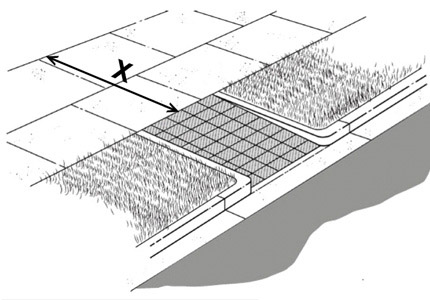 When pedestrians are not required to walk across the ramp, such as where there is a non-walking surface (grass, for example) or obstructions on both sides of a curb ramp, curb ramps are allowed to have returned curbs. A curb ramp with returned curbs is required to have a landing with maneuvering space at the top of the ramp (“x” in the illustration to the left) that is at least 48 inches because people using mobility devices need an area to turn when getting on and off the ramp. [§ 4.7.5; Fig. 12(b)] When pedestrians are not required to walk across the ramp, such as where there is a non-walking surface (grass, for example) or obstructions on both sides of a curb ramp, curb ramps are allowed to have returned curbs. A curb ramp with returned curbs is required to have a landing with maneuvering space at the top of the ramp (“x” in the illustration to the left) that is at least 48 inches because people using mobility devices need an area to turn when getting on and off the ramp. [§ 4.7.5; Fig. 12(b)] |
F. What are Pedestrian Crossings and Where Must Curb Ramps be Provided?
Where and when curb ramps are required depends on the location and the age of streets and sidewalks.
1. Location
Generally, you must provide curb ramps wherever a sidewalk or other pedestrian walkway crosses a curb. Curb ramps must be placed to enable a person with a mobility disability to travel from a sidewalk on one side of the street, over or through any curbs or traffic islands, to the sidewalk on the other side of the street. Remember, walkways include areas where people must walk to access bus stops and other public transportation stops, so, where necessary, curb ramps must also be provided to enable people with disabilities to board and exit public transportation.
2. Age of Streets and Sidewalks
In addition, the requirements vary depending on the age of a highway, road, street, or sidewalk, and depending on when and whether it was paved, repaved, resurfaced beyond normal maintenance, or otherwise altered.
“Pre-ADA” streets, sidewalks, roads, and highways are those that were built before January 26, 1992, and have not since been altered.
“Alterations” are another category of construction under the ADA. A street or sidewalk falls into this category if it was constructed pre-ADA (construction began before January 26, 1992), and has since been altered. What does “altered” mean? An alteration is a change that affects usability. Resurfacing a roadway beyond normal maintenance is an alteration. By contrast, filling potholes is not.8
For purposes of the ADA, any street or sidewalk is “new” or “post-ADA” if its construction commenced after January 26, 1992.9
7 The bracketed references in this section refer to the applicable sections of the ADA Standards
8 28 C.F.R. § 35.151(b).
9 28 C.F.R. § 35.151(a).
3. New Construction vs. Alterations
The requirements in the ADA Standards for curb ramps newly constructed post-ADA (construction commenced after January 26, 1992) can be found in § 4.7. The requirements for curb ramps that have been altered post-ADA are the same, except for in the following cases.
When pre-ADA streets or sidewalks are altered, there may be space limitations that restrict how much they can be altered to install accessible curb ramps. In these cases, the curb ramps installed must meet the accessibility requirements of the ADA to the maximum extent feasible.10 Scoping requirements in the ADA Standards establish limitations for the running slope of the ramp run of curb ramps installed during alterations to pre-ADA streets and walkways.11
The Civil Rights Division recognizes that there will be very rare instances when it will be technically infeasible for a curb ramp installed during alterations to pre-ADA roadways and walkways to be constructed in full and strict compliance with the requirements of ADA Standards § 4.1.6(3)(a) and § 4.7 because of physical or site constraints. In such circumstances, state and local governments must install curb ramps that provide accessibility to the maximum extent feasible.12 Before reaching a conclusion about technical infeasibility, state and local governments need to consider the extent to which physical or site constraints can be addressed by alternative curb ramp designs. The burden of proving technical infeasibility lies with the state or local government that constructed it.
Alternative Curb Ramp Designs
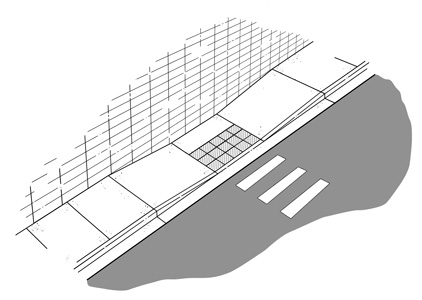 |
A parallel curb ramp consists of two ramps joined in the middle by a landing that is level with the roadway. Parallel curb ramps run parallel to the curb and usually take up the whole width of the sidewalk. Combined curb ramps are a combination of the perpendicular and parallel curb ramp designs. The combined curb ramp breaks the elevation change between the curb and the street into two parts, and uses a separate ramp to bridge each part: a parallel ramp from the sidewalk to a level landing, and a perpendicular ramp from the level landing to the roadway. |
When highways, streets, and roads are built or altered post-ADA, they must have curb ramps at certain locations. Curb ramps must be located wherever there are curbs or other barriers to entry from a pedestrian walkway or sidewalk, including any intersection where it is legal for a pedestrian to cross the street, whether or not there is any designated crosswalk. Curb ramps must also be located wherever there are curbs or other barriers to entry at any designated pedestrian crosswalks that are located mid-block. Likewise, when sidewalks or walkways are built or altered post-ADA, they must include curb ramps or other sloped areas wherever they intersect with highways, streets, or roads and pedestrians may legally cross the vehicular way as well as at public transportation stops.
By contrast, for pre-ADA highways, streets, roads, and sidewalks that have not been altered, state and local governments may choose to construct curb ramps at every point where a pedestrian walkway intersects a curb. However, they are not necessarily required to do so. Under a more flexible standard called “program access,” alternative routes to buildings may be acceptable where people with disabilities must travel only a marginally longer route than the general public.
4. Example: Installing Curb Ramps for Program Accessibility
Consider a case where the streets and sidewalks in a small town were built pre-ADA and have not been altered since. Some intersections have curb ramps; most do not. The town is trying to figure out where to install curb ramps to provide access to the town hall. The accessible entrance to the town hall is located on North Street, which is on the north side of the building. The parking garage that serves the town hall is located on North Street, directly across the street from the town hall’s accessible entrance. Public transportation stops serving the town hall are in a residential neighborhood on East Street, two blocks east of the town hall. The town is evaluating where it needs to install curb ramps to comply with Title II requirements.
Since the town hall and its surrounding streets and sidewalks were built pre-ADA and have not since been altered, the town must install curb ramps in compliance with Title II’s program access requirements for pre-ADA facilities. Under these requirements, the town may choose to install curb ramps at all pedestrian crossings on the sidewalks surrounding the town hall, but it is not necessarily required to do so. A program access approach would require the town to install curb ramps at key pedestrian crossings. To provide access to the town hall, curb ramps would need to be installed at the pedestrian crossings and transportation stops along North and East streets so people with disabilities can travel along a pedestrian route between (1) the accessible entrance to the town hall and the accessible entrance to the parking garage and (2) the accessible entrance to the town hall and the public transportation stops on East Street. In this instance, installing curb ramps at the pedestrian crossings on the south side of the townhall are not needed from a program access perspective to enable people with disabilities to access the town hall. However, they may be needed from a program access perspective for other reasons, such as providing access to other town facilities served by the parking garage or to the town’s business district. The town should seek input from people with mobility disabilities regarding the other key locations where curb ramps need to be installed to provide program access.
G. What are Detectable Warnings, Why are They Required, and Where Must They be Provided?
The ADA Standards require that curb ramps include features called “detectable warnings.” Detectable warnings consist of a series of small domes that contrast in color with the surrounding sidewalk or street. They must be integrated into the walking surface, and there are specific measurements for the size and spacing of the domes.13
What is the function of detectable warnings? Detectable warnings are intended to function much like stop signs for pedestrians who are blind or have low vision. The warnings, which are intended to be felt with pedestrians’ feet, alert blind individuals and those with low vision that they are about to enter a street or other area where cars pass. A detectable warning alerts pedestrians who are blind or have low vision that they need to stop and determine the nature of the hazard – such as whether there is passing traffic – before continuing on their way.
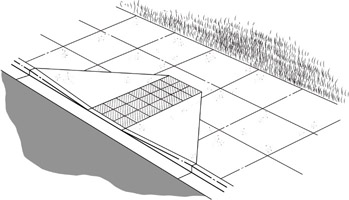 Under the ADA Standards, curb ramps are required to have detectable warnings that extend the full width and depth of the curb ramp.14 An example of a perpendicular curb ramp that complies with this requirement can be seen to the left.
Under the ADA Standards, curb ramps are required to have detectable warnings that extend the full width and depth of the curb ramp.14 An example of a perpendicular curb ramp that complies with this requirement can be seen to the left.
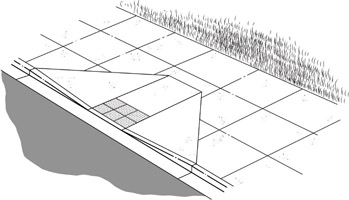 The U.S. Department of Transportation (DOT), however, is encouraging the use of a different design for detectable warnings.15 Under this design, detectable warnings extend the whole width of the ramp, but cover only the two feet of the ramp closest to the street. DOT has deemed this departure from the ADA Standards to be permitted under Title II of the ADA.16 An example of a curb ramp that complies with the DOT’s design can be seen on the right.
The U.S. Department of Transportation (DOT), however, is encouraging the use of a different design for detectable warnings.15 Under this design, detectable warnings extend the whole width of the ramp, but cover only the two feet of the ramp closest to the street. DOT has deemed this departure from the ADA Standards to be permitted under Title II of the ADA.16 An example of a curb ramp that complies with the DOT’s design can be seen on the right.
H. How Can You Tell if a Curb Ramp is Accessible?
The best way to determine if a curb ramp is accessible is to survey it to
determine the extent to which it complies with ADA accessibility requirements.
To assist you, the next installment of this Tool Kit will include instructions on how
to survey curb ramps for compliance with the ADA Standards and a Curb Ramps
survey form for use in conducting your surveys. The instructions, which will be
located in Appendix 1, are keyed to the Curb Ramps survey form, which will be
located in Appendix 2, and will provide an explanation of how to obtain the
information needed to answer each question on the survey form. The
instructions will also include photographs and illustrations showing how and
where to take measurements. The Curb Ramps survey form and instructions will
help you identify the most common accessibility problems with curb ramps, but
they will not necessarily identify all problems.
13 ADA Standards § 4.29.2.
14 ADA Standards § 4.7.7.
15 DOT’s memorandum encouraging use of this alternate design for detectable warnings is
available on its website at www.fhwa.dot.gov/environment/bikeped/dwm.htm.
16 28 C.F.R. § 35.151(c)
I. Ensuring Compliance Now and In the Future
Now that you know some of the basic ADA requirements for providing curb ramps at pedestrian crossings, you can assess whether your entity is in compliance with these requirements. Here are some steps you can take:
- Assess the extent to which your entity has complied with ADA
requirements for providing curb ramps at pedestrian crossings and transportation stops. Use the Checklist in the Addendum to this Chapter
to guide you in conducting a preliminary assessment. To survey curb
ramps in your community, use the Curb Ramps survey form and
instructions that will be included in the Appendices to this Tool Kit, which
will be released soon.
- After conducting your assessment to figure out where ADA compliant
curb ramps are needed, prioritize the locations. If locations
constructed or altered post-ADA do not have ADA-compliant curb ramps,
they must be installed at all of those locations. Other priorities include, in
descending order, curb ramps at pre-ADA locations with pedestrian
crossings providing access to local government facilities, bus stops and
other transportation services, public accommodations, business districts,
and residential areas.
- Next, make a long-range plan to provide curb ramps in locations that
need them. When making the plan, include other local government staff
who will be involved, such as employees from the transportation
department and employees in charge of budget matters. Set a series of
progress dates for curb ramp compliance based on priorities and
reasonable time frames. The actual number of curb ramps installed in any
given year may be limited by fiscal constraints, consistent with the
fundamental alteration and undue burden limitations discussed in
Chapter 1 of the Tool Kit. However, the plan should address the steps
your entity will take over a specific time period to come into compliance
with Title II requirements.
- Establish written procedures for soliciting and receiving input on the
accessibility of pedestrian crossings and transportation stops from
people with disabilities. As part of these procedures, establish an
ongoing program for installing curb ramps upon request in both residential
and nonresidential areas.17 Integrate these requests into your long-range
plan. This program will put your entity on the right track for the future.
- Develop a written policy ensuring that, effective immediately, ADA-compliant
curb ramps will be provided at any intersection having curbs or
other barriers to entry from a sidewalk whenever a street, road, or highway
is constructed or altered. If your entity receives federal financial
assistance, the policy should also address compliance with Section 504.
- Develop a written policy ensuring that, effective immediately, ADA-compliant
curb ramps will be provided at all newly constructed or altered
sidewalks and walkways where they intersect a street, road, or highway, including mid-block pedestrian crossings and public transportation stops.
If pedestrians may legally cross a street at an intersection that you are
constructing or altering, curb ramps must be provided.
- Working with employees in the transportation department, review the
designs for curb ramps and detectable warnings to ensure that they
are ADA-compliant. If your entity receives federal financial assistance,
they also should be reviewed for compliance with Section 504. Many
states and localities have standardized designs for common features such
as curb ramps, and sometimes these designs do not comply with ADA
and, if applicable, Section 504 requirements. If your curb ramp designs,
including the details for detectable warnings, do not comply with Title II
requirements your entity needs to change them immediately so they do.
- Many sidewalks and roads become the responsibility of public entities
after they are built by private developers and deeded over to the public
entity following construction. Often, in these circumstances, private
developers (who are not bound by Title II’s requirements when acting on
their own behalf) have not provided the curb ramps at pedestrian
crossings, transportation stops, and other locations that the ADA requires
public entities to provide. When these facilities are deeded over to them,
public entities also receive the legal responsibility for installing ADA-compliant
curb ramps which previously may not have existed. But public
entities can use their authority under zoning and land use laws, as
well as plan review processes, to ensure that private developers
comply with the accessibility requirements that public entities deem
appropriate. Some communities that understand the liability they can
incur in receiving such property refuse to accept property that has not
been built in compliance with ADA requirements.
- Most public entities include provisions in their contracts for services
with architects, engineers, and contractors requiring compliance
with applicable federal, state, and local laws. However, many
architects, engineers, and contractors do not understand that these
provisions require compliance with ADA requirements. When
preparing contracts for services by architects, engineers, and
contractors involved in building and altering highways, streets,
roads, sidewalks, other walkways, transportation stops, and curb
ramps, consider including a provision specifically requiring
compliance with Title II of the ADA, including compliance with the
ADA Standards or UFAS. Remember, public entities may not use the
elevator exception contained in ADA Standards, § 4.1.3(5). While
elevators will rarely be implicated in the design and construction of
pedestrian crossings, they will be implicated in many other types of public
facilities constructed by or on behalf of public entities. For this reason, a contractual provision requiring compliance with the ADA Standards should
make clear that the elevator exception contained in § 4.1.3(5) of the
Standards does not apply. If your entity receives federal financial
assistance, consider a similar provision requiring compliance with Section
504 requirements as well.
- Where compliance with federal law is contractually required, consider requiring your architects, engineers, and contractors to certify ADA compliance, including compliance with the ADA Standards (excluding the elevator exception in § 4.1.3(5) of the Standards) or UFAS, before accepting, and making final payments for, their work. If your entity receives federal financial assistance, consider requiring architects, engineers, and contractors to certify compliance with Section 504 requirements as well.
ADA Tool Kit for State and Local Governments
May 7, 2007

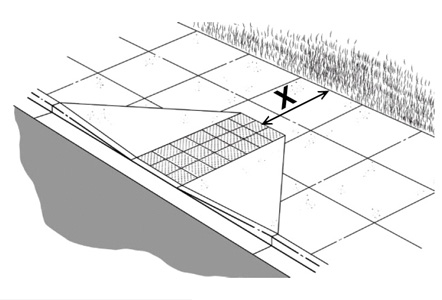 The most common type of curb ramp is the perpendicular curb ramp, which intersects the curb at a 90-degree angle. Curb ramps must have flared sides if people are required to walk across them. [§ 4.7.5] The slope requirements for the flared sides depend on the width of the sidewalk at the top of the ramp, “x” in the illustration to the right. If “x” is less than 48 inches, then the slope of the flared sides must be no more than 8.33 percent (1:12). If “x” is 48 inches or more, then the flared sides may slope up to 10 percent (1:10) but not more. [§ 4.7.5; Fig. 12(a)]
The most common type of curb ramp is the perpendicular curb ramp, which intersects the curb at a 90-degree angle. Curb ramps must have flared sides if people are required to walk across them. [§ 4.7.5] The slope requirements for the flared sides depend on the width of the sidewalk at the top of the ramp, “x” in the illustration to the right. If “x” is less than 48 inches, then the slope of the flared sides must be no more than 8.33 percent (1:12). If “x” is 48 inches or more, then the flared sides may slope up to 10 percent (1:10) but not more. [§ 4.7.5; Fig. 12(a)]